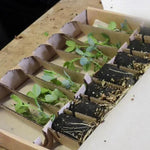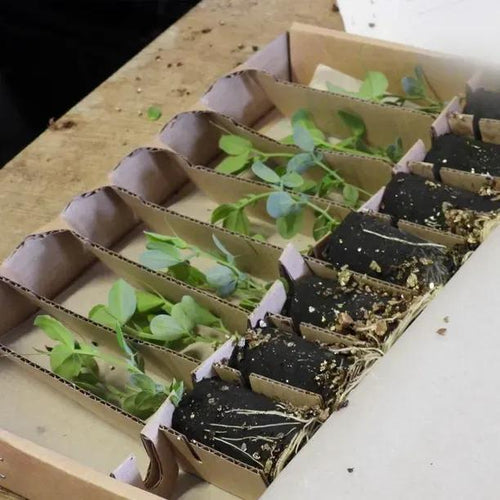Heaven Scent Sweet Pea Plants
Heaven Scent is an utterly reliable and charming Spencer sweet pea with an unbeatably rich fragrance. It has extra large flowers and long straight stems, perfect for cutting, if you can bear to deprive your garden of these flowers early (solution: grow more of them!). The pale salmon blushes appear to waft over the ruffled outer edges and middle of the petals, which are a lovely intense cream colour in the recesses. Stunning to look at and a strong grower, it should be a definite in any cutting garden or potager.
Our Sweet Peas are delivered in purpose-designed, recycled cardboard packaging, and are ready to be planted out when you get them.
We generally send them out between March and May, but we will email you with the likely delivery timescale once you have placed your order.
Growing Heaven Scent Sweet Peas
Try growing it with the beautiful blue Spencer, Just Julia. When training Heaven Scent up a pergola, structure or stairway, bear in mind that it tends to produce most of its flowers nearer the top of the plant, unlike the more old-fashioned sweet pea varieties with smaller flowers. This feature works well if Heaven Scent is emerging from a border or is planted behind a rose like Penelope, thus hiding its less showy lower stems.
If you grow a sweet pea or two with your runner beans, it helps with pollination; Heaven Scent is a perfect match for runner beans with cream or white flowers.
Features
- Colour: apricot/pink on cream
- Stem: long and straight
- Height: up to 2.2 m
- Type: Spencer
- Scent: very fragrant
- Flowering: May to August
- Planting Months: March-June
History & Trivia
The first sweet pea seeds arrived in Britain around 1700, when a Franciscan monk from Sicily, Franciscus Cupani (1657-1710), sent samples to botanists around Europe, including Dr Robert Uvedale (1642–1722), a cleric and the former master of Enfield Grammar School in Middlesex.
This variety was released onto the market in 2007, bred by Sydney Harrod at Cooltonagh in Ireland.

 Secure, One-Tap Checkout
Secure, One-Tap Checkout
 Hand Picked, Delivered to Your Door!
Hand Picked, Delivered to Your Door! 1 Year Bareroot Guarantee
1 Year Bareroot Guarantee




